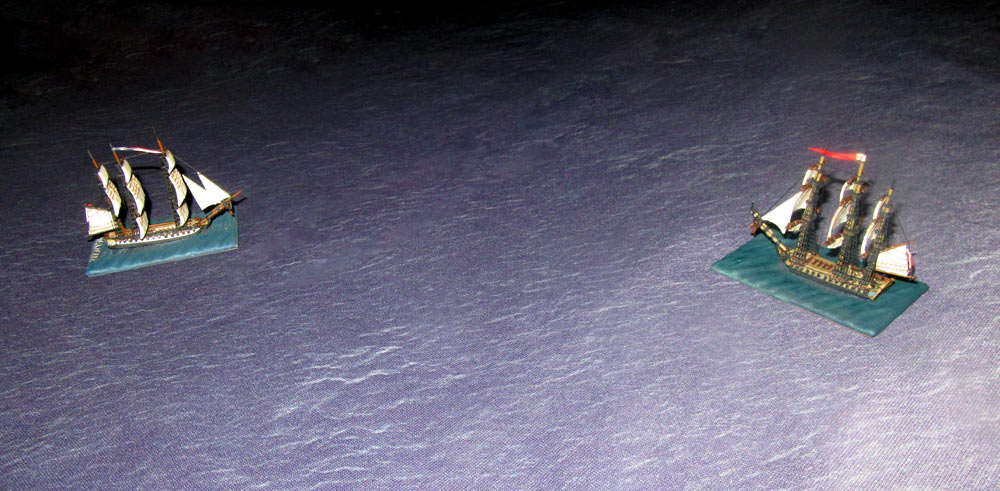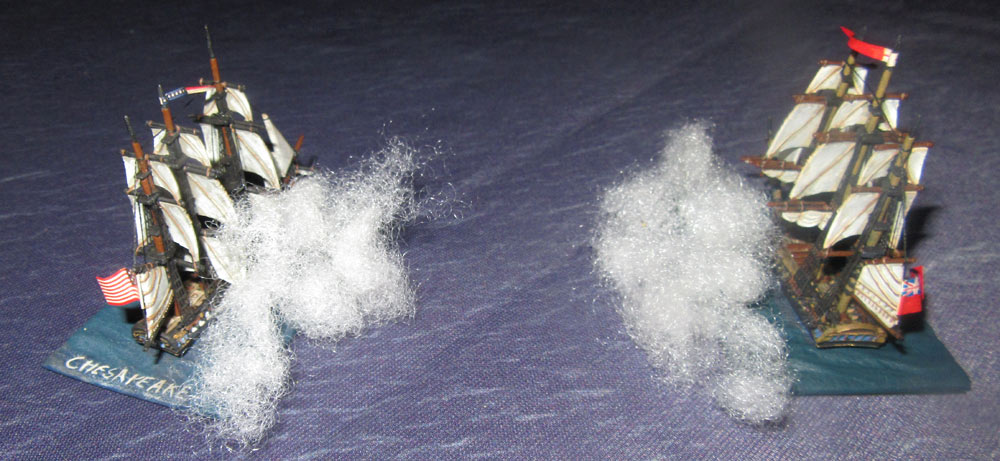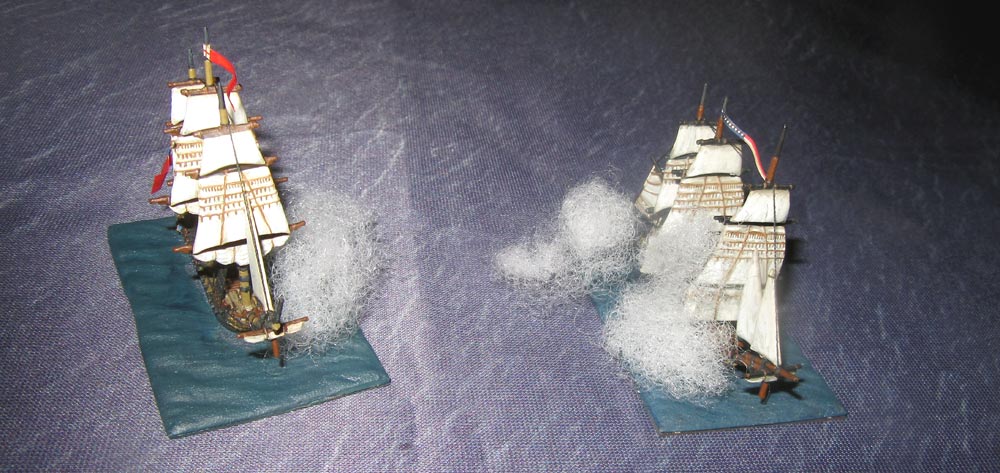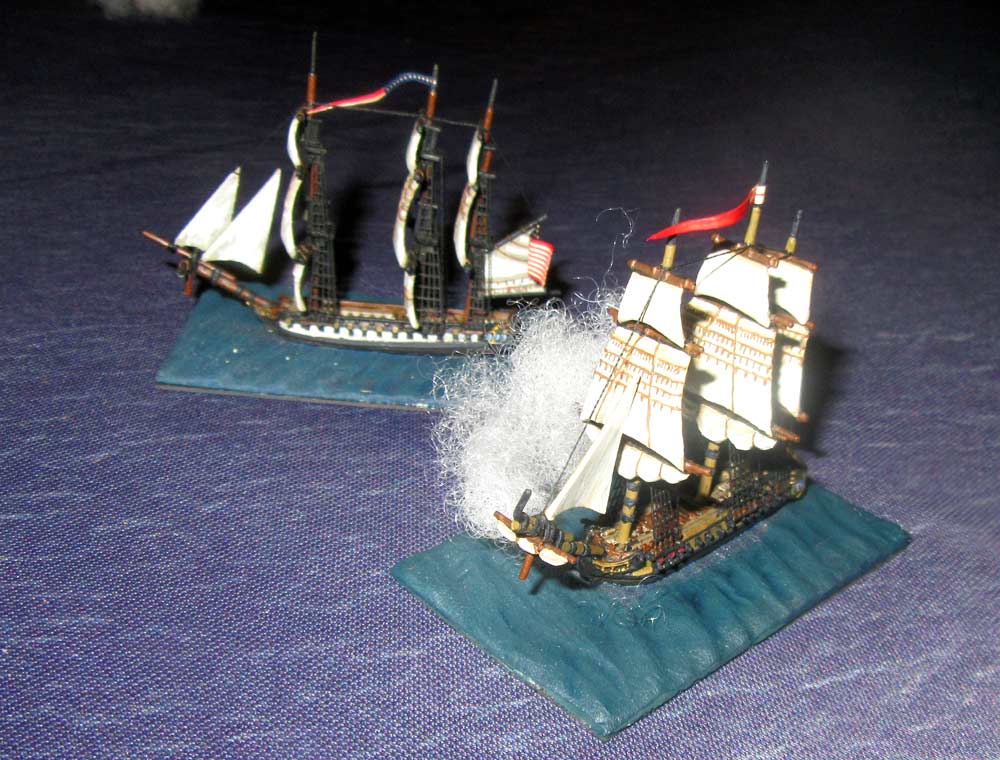
Guns off Cape Ann, 1813
15th January 2022, 0 Comments
The Age of Fighting Sail, Post Captain, 1/1200 scale
Two naval games back to back is a rarity. To be fair, in between, during the whole Christmas and New Year period, the wargame club here has been closed. In fact its still shut, thanks to Covid, although with luck that’ll change soon. So, this game was played at home, with two wargaming chums. One of them, Nick, asked for a Napoleonic single-ship action game, so this is exactly what we did.  You don’t get much more of a classic frigate duel than the clash between USS Chesapeake and USS Shannon off Cape Ann, Massachusetts in June 1813. This was fought just outside Boston Harbor, and came after a string of British defeats in similar actions, albeit against American “super-frigates”. In this one though, the odds were even – two 32 gun frigates squaring off against each other. In our game, Mally commanded the Chesapeake, Nick the Shannon, and I sort of umpired while drinking gin.
You don’t get much more of a classic frigate duel than the clash between USS Chesapeake and USS Shannon off Cape Ann, Massachusetts in June 1813. This was fought just outside Boston Harbor, and came after a string of British defeats in similar actions, albeit against American “super-frigates”. In this one though, the odds were even – two 32 gun frigates squaring off against each other. In our game, Mally commanded the Chesapeake, Nick the Shannon, and I sort of umpired while drinking gin.  The game was played on a 6×4 foot table, with Chesapeake coming on in the centre of the western (long) table edge. Shannon was waiting for her a little to the south-east. Once on the table, both ships began to cautiously approach each other. The wind was blowing from the north, giving the Chesapeake the weather gage. So, to approach her Nick had to sail close to the wind, and eventually had to tack. So, it was a slow approach, which ended when Nick decided to open fire, followed a minute later by Mally.
The game was played on a 6×4 foot table, with Chesapeake coming on in the centre of the western (long) table edge. Shannon was waiting for her a little to the south-east. Once on the table, both ships began to cautiously approach each other. The wind was blowing from the north, giving the Chesapeake the weather gage. So, to approach her Nick had to sail close to the wind, and eventually had to tack. So, it was a slow approach, which ended when Nick decided to open fire, followed a minute later by Mally.  These opening broadsides were fired at long range – around 600 yards, with both sides aiming for the enemy’s rigging. A few blocks were knocked off, but nothing more spectacular. The cautious approach continued, with both crews furiously reloading. Meanwhile, Shannon had tacked, and so both ships were now approaching each other more directly, with Chesapeake running with the northerly breeze astern of her. and Shannon creeping forward close-hauled, sailing as close to the wind as she could.
These opening broadsides were fired at long range – around 600 yards, with both sides aiming for the enemy’s rigging. A few blocks were knocked off, but nothing more spectacular. The cautious approach continued, with both crews furiously reloading. Meanwhile, Shannon had tacked, and so both ships were now approaching each other more directly, with Chesapeake running with the northerly breeze astern of her. and Shannon creeping forward close-hauled, sailing as close to the wind as she could. 
Then, when both ships got within 250 yards of each other (10 ), the broadsides started again. This time Shannon had turned to starboard, putting herself on Chesapeake’s port beam. This was a pretty murderous exchange, with both ships firing simultaneously, and both suffering damage to guns, crew, hull and rigging. A particularly telling hit was when Chesapeake’s wheel got shot away, forcing Mally to send crew off to rig steering ropes to the rudder. Meanwhile the American frigate kept on her original course.  As if that wasn’t enough they both repeated the simultaneous broadsides two minutes later, as they continued to run southwards, but were now just 150 yards (6″) apart. Nick had tried to haul in sail to fall astern of Chesapeake, and then turn across her stern to deliver a raking broadside. He hadn’t quite got into position for that though, and the two sides traded close range broadsides again. Again, both ships suffered, but notably Chesapeake had her rudder damaged, while on Shannon a small fire was started on her gundeck.
As if that wasn’t enough they both repeated the simultaneous broadsides two minutes later, as they continued to run southwards, but were now just 150 yards (6″) apart. Nick had tried to haul in sail to fall astern of Chesapeake, and then turn across her stern to deliver a raking broadside. He hadn’t quite got into position for that though, and the two sides traded close range broadsides again. Again, both ships suffered, but notably Chesapeake had her rudder damaged, while on Shannon a small fire was started on her gundeck.  At that point Nick finally managed to get astern of Chespapeake, and fired his raking broadside. Unfortunately for him it didn’t do much – only chop down the American’s mizzen top, and pepper her hull a bit. With that the two ships drew apart, with Chesapeake now not only sticking to her previous course, but now turning one point to starboard – into the wind – in each one minute long phase. In other words Mally was in real trouble, and by rights Shannon should be able to range up astern and rake the American until she struck.
At that point Nick finally managed to get astern of Chespapeake, and fired his raking broadside. Unfortunately for him it didn’t do much – only chop down the American’s mizzen top, and pepper her hull a bit. With that the two ships drew apart, with Chesapeake now not only sticking to her previous course, but now turning one point to starboard – into the wind – in each one minute long phase. In other words Mally was in real trouble, and by rights Shannon should be able to range up astern and rake the American until she struck.  Unfortunately, Shannon had other problems. That fire was taking hold, and if it wasn’t put out within four turns (12 minutes), the ship would have to be abandoned. So, Nick took Shannon south and west in a wide look around the largely helpless Chesapeake. Those of her crew who weren’t fighting the flames were busily double-shotting the guns. Nick clearly intended to finish off the American.
Unfortunately, Shannon had other problems. That fire was taking hold, and if it wasn’t put out within four turns (12 minutes), the ship would have to be abandoned. So, Nick took Shannon south and west in a wide look around the largely helpless Chesapeake. Those of her crew who weren’t fighting the flames were busily double-shotting the guns. Nick clearly intended to finish off the American. Meanwhile, Chesapeake gradually turned to starboard, and eventually headed into irons – directly into the wind. Her crew had rigged their jury steering ropes, but without a working rudder they’d be useless. So, the Rigging and Repair phase was now crucial for both players. Nick needed a 1-3 on a D12 to put out the fire, and he failed the roll – three times. Mally was having the same bad luck with his rudder repairs, needing a 1-2 to succeed. Still, Nick only had one more roll to make, or he’d have to take to the boats.
Meanwhile, Chesapeake gradually turned to starboard, and eventually headed into irons – directly into the wind. Her crew had rigged their jury steering ropes, but without a working rudder they’d be useless. So, the Rigging and Repair phase was now crucial for both players. Nick needed a 1-3 on a D12 to put out the fire, and he failed the roll – three times. Mally was having the same bad luck with his rudder repairs, needing a 1-2 to succeed. Still, Nick only had one more roll to make, or he’d have to take to the boats.  Before he did, he decided on a potentially last long-ranged (500 yard) starboard broadside, which damaged Chesapeake’s rigging and forced a rigging check. Mally’s mast held, but even if she got her rudder fixed, she wouldn’t be nearly as nimble as she’d been before. Then came the all-important Rigging and Repair Check. Mally rolled a 5, failing it again, and then Nick rolled … a 10. So, with the fire raging unchecked, the unwilling captain of Shannon ordered his crew into the boats. That, of course, marked the end of the game.
Before he did, he decided on a potentially last long-ranged (500 yard) starboard broadside, which damaged Chesapeake’s rigging and forced a rigging check. Mally’s mast held, but even if she got her rudder fixed, she wouldn’t be nearly as nimble as she’d been before. Then came the all-important Rigging and Repair Check. Mally rolled a 5, failing it again, and then Nick rolled … a 10. So, with the fire raging unchecked, the unwilling captain of Shannon ordered his crew into the boats. That, of course, marked the end of the game. 
It was an unusual end to a frigate duel, ad frankly Mally had been lucky. Nick had defied the odds with his damage control rolls, and so the Chesapeake was able to claim victory, and so limp back into Boston with honour intact. In fact it could have gone very badly indeed for the Americans, if only the British had been better at firefighting! The two players – and the umpire – thoroughly enjoyed the game though, and Nick is now keen to build up a small frigate force of his own, if he can find someone to help him with the rigging..

